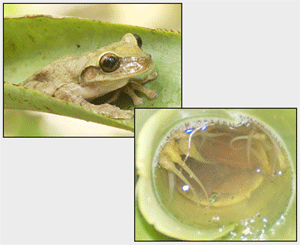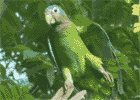There are 21 native species of frogs on Jamaica: all 21 natives are endemic - their natural range is restricted entirely to Jamaica. Our endemic frogs are divided into two families: Hylidae (True Treefrogs) and Eleutherodactylidae (Rainfrogs).
 |
| A "Laughing Treefrog" and her tadpoles. |
Eleutherodactylidae evolved a clever solution to the absence of reliable surface water in a limestone forest: females find a nice humid microhabitat, such as under decaying vegetation or amongst the leaves of bromeliads, and direct development occurs within the egg -- instead of tadpoles, baby froglets, which look almost exactly like an adult, emerge from the eggs. Their development and survival depends on two things: (1) ambient humidity remains high, so the eggs don't dessicate; and (b) parental care - protection of the eggs from predators. Interestingly, in most species of Eleutherodactylidae, it is the male which guards the eggs.
Four introduced species of anurans have become established to Jamaica. One of the most insidious has been the cane toad (Rhinella marina), which was introduced in 1844 as a biological control agent to combat rats and invertebrate pests of sugar cane. Not only does this invasive alien species have a voracious appetite -- if it moves, it's food for a cane toad -- but all stages of the life cycle (eggs, tadpoles, and adults) produce strong toxins (bufogenins), which are lethal to many animals if ingested. For example, we know that wild Jamaican Boas die if they accidentally swallow a cane toad. If you accidentally or intentionally handle a cane toad, be sure to wash your hands with soap and water!
Checklist nomenclature follows Blair Hedges' CaribHerp website. You also will find photographs, distribution maps, and recordings of vocalisations on this very useful website.
To see more terrific photos of Jamaican frogs and other anurans found throughout the Caribbean, visit Alejandro Sanchez' website of Caribbean Natural History.
To learn about our 2013-2014 frog surveys in the Catadupa Key Biodiversity Area (western Cockpit Country), click here.
.
.
.
Last updated: 7th April 2016
| COMMON NAME | SCIENTIFIC NAME | IUCN REDLIST | RANGE | OCCURS IN COCKPIT COUNTRY |
| Bufonidae | ||||
| Cane Toad | Rhinella marina | Least concern | Widespread (Introduced invasive alien) |
Yes |
| Hylidae | ||||
| Jamaican Snoring Treefrog | Osteopilus crucialis | Endangered | Jamaica | Yes |
| Jamaican Laughing Treefrog | Osteopilus ocellatus formerly O. brunneus |
Least concern | Jamaica | Yes |
| Jamaican Yellow Treefrog | Osteopilus marianae | Endangered | Jamaica | Yes |
| Jamaican Green Treefrog | Osteopilus wilderi | Endangered | Jamaica | Yes |
| Undescribed Treefrog | Osteopilus sp. (Holmes 2011) | Not evaluated | Jamaica | Yes (poss. restricted to CC) |
| Eleutherodactylidae | ||||
| Jamaican Peak Frog | Eleutherodactylus alticola | Critically endangered | Blue Mountains | No |
| Jamaican Rumpspot Frog | Eleutherodactylus andrewsi | Endangered | Blue Mountains | No |
| Portland Ridge Frog | Eleutherodactylus cavernicola | Critically endangered | Portland Ridge | No |
| Jamaican Rock Eleuth | Eleutherodactylus cundalli | Vulnerable | Western Jamaica | Yes |
| Jamaican Earspot Frog | Eleutherodactylus fuscus | Critically endangered | Western Jamaica | Yes |
| Blue Mountain Rock Frog | Eleutherodactylus glaucoreius | Near threatened | Eastern Jamaica | No |
| Jamaican Forest Frog | Eleutherodactylus gossei | Least concern | Jamaica | Yes |
| Jamaican Pallid Frog | Eleutherodactylus grabhami | Endangered | Western Jamaica | Yes |
| Cockpit Frog | Eleutherodactylus griphus | Critically endangered | Cockpit Country | Yes |
| Jamaican Bromeliad Frog | Eleutherodactylus jamaicensis | Endangered | Jamaica | Yes . . . but not seen since 1987 (Hedges and Diaz 2011, Holmes et al. 2012) |
| Lesser Antillean Frog | Eleutherodactylus johnstonei | Least concern | Widespread (Introduced invasive alien) |
Yes |
| Rock Pocket Frog | Eleutherodactylus junori | Critically endangered | Central Jamaica | Yes |
| Jamaican Masked Frog | Eleutherodactylus luteolus | Endangered | Western Jamaica | Yes |
| Jamaican Red-eyed Frog | Eleutherodactylus nubicola | Endangered | Blue Mountains | No |
| Jamaican Stream Frog | Eleutherodactylus orcutti | Critically endangered (poss. extinct) |
Blue Mountains | No |
| Jamaican Yellow-bellied Frog | Eleutherodactylus pantoni | Near threatened | Central & western Jamaica | Yes |
| John Crow Yellow-bellied Frog | Eleutherodactylus pentasyringos | Vulnerable | Eastern Jamaica | No |
| Cuban Flathead Frog | Eleutherodactylus planirostris | Least concern | Widespread (Introduced invasive alien) |
Yes |
| Leaf Mimic Frog | Eleutherodactylus sisyphodemus | Critically endangered | Cockpit Country | Yes |
| Ranidae | ||||
| Bullfrog | Lithobates catesbianus | Least concern | Widespread (Introduced invasive alien) |
Yes |
References
Crombie, R.I. 1977. A new species of frog of the genus Eleutherodactylus (Amphibia: Leptodactylidae) from the Cockpit Country of Jamaica.
Proceedings of the Biological Society of Washington, DC 90: 194-204.
Crombie, R.I. 1986. Another new forest-dwelling frog (Leptodactylidae: Eleutherodactylus) from the Cockpit Country of Jamaica. Transactions of the San Diego Society of Natural History 21: 145-153.
Dunn, E.R. 1926. No.4 - The frogs of Jamaica. Proceedings of the Boston Society of Natural History 38:111-130.
Frost, D.R. 2015. "Genus Eleutherodactylus" Amphibian Species of the World: an Online Reference. Version 6.0. American Museum of Natural History. Date accessed: 1st December 2015.
Hedges, S. B. 1987. Vocalization and habitat preference of the Jamaican treefrog, Hyla marianae (Anura, Hylidae). Carib. J. Sci. 23:380-384. http://www.hedgeslab.org/pubs/10.pdf
Hedges, S.B. 1989. An island radiation: allozyme evolution in Jamaican frogs of the genus Eleutherodactylus (Leptodactylidae). Caribbean Journal of Science 25:123-147. http://www.hedgeslab.org/pubs/18.pdf
Hedges, S.B. 2015 Caribherp: Amphibians and reptiles of Caribbean Islands. www.caribherp.org on-line database. Date accessed: 1st December 2015.
Hedges, S.B. and L.M. Diaz. 2011. The conservation status of amphibians in the West Indies. Pp. 31-47 In A.Hailey, B. Wilson, and J. Horrocks (eds.) Conservation of Caribbean Island Herpetofaunas Volume 1: Conservation Biology and the Wider Caribbean. Brill, Leiden, The Netherlands. http://www.hedgeslab.org/pubs/230.pdf
Holmes. I. 2011. Checking in with Jamaica's endangered frogs. FrogLog vol. 98, pg 38.
Holmes, I., K. McLaren, and B. Wilson. 2012. Surveys for frog diversity and Batrachochytrium dendrobatidis in Jamaica. Herpetological Review 43: 278-282.
Lewis, C. B. 1949. Toads and frogs. In: Lewis CB (ed) Glimpses of Jamaican Natural History, Vol. 1. The Institute of Jamaica, Kingston, pp 24–26.
Mahon, R. and K. Aiken. 1977. The establishment of the North American Bullfrog, Rana catesbeiana (Amphibia, Anura, Ranidae) in Jamaica. Journal of Herpetology 11:197-199.
Pregill, G.K., R.I. Crombie, D.W. Steadman, L.K. Gordon, F.W. Davis, and W.B. Gartner. 1991. Living and Late Holocene fossil vertebrates, and the vegetation of the Cockpit Country, Jamaica. Atoll Research Bulletin No. 353. Issued by National Museum of Natural History, Smithsonian Institution, Washington, D.C.
Schwartz, A. and D.C. Fowler. 1973. The Anura of Jamaica: A Progress Report. Study of the Fauna of Curacao and Other Caribbean Islands: No. 142, pp 50-142. http://www.repository.naturalis.nl/document/549921
Schwartz, A. and R. W. Henderson. 1991. Amphibians and reptiles of the West Indies: Descriptions, distributions, and natural history. University of Florida Press, Gainesville, Florida.
Ward, C. 2014. Industry threatening to eliminate endemic Jamaican frogs. FrogLog (Issue no. 109) vol. 22: 48-49.
Wilson, B.S., S.E. Koenig, R. van Veen, E. Miersma, D. C. Rudolph. 2010. Cane toads a threat to West Indian wildlife: mortality of Jamaican boas attributable to toad ingestion. Biological Invasions. Published on-line 1 June 2010: DOI 10.1007/s10530-010-9787-7.

